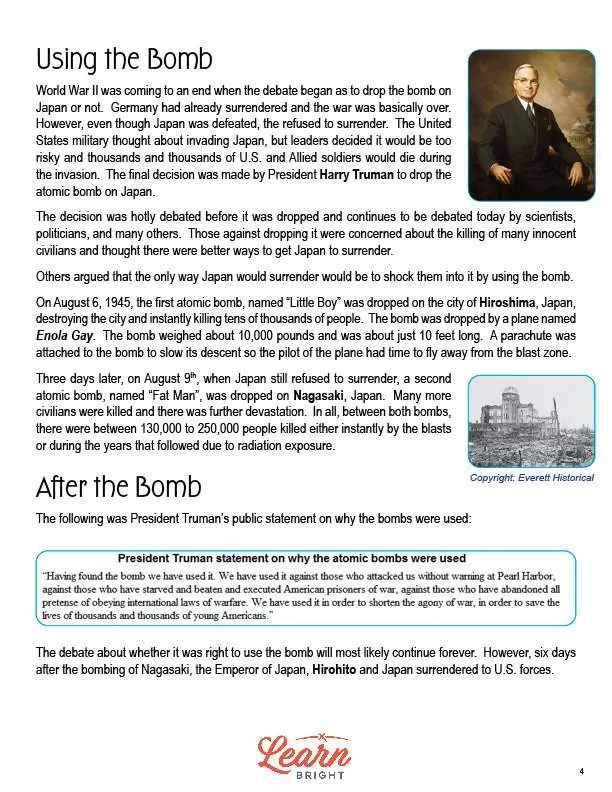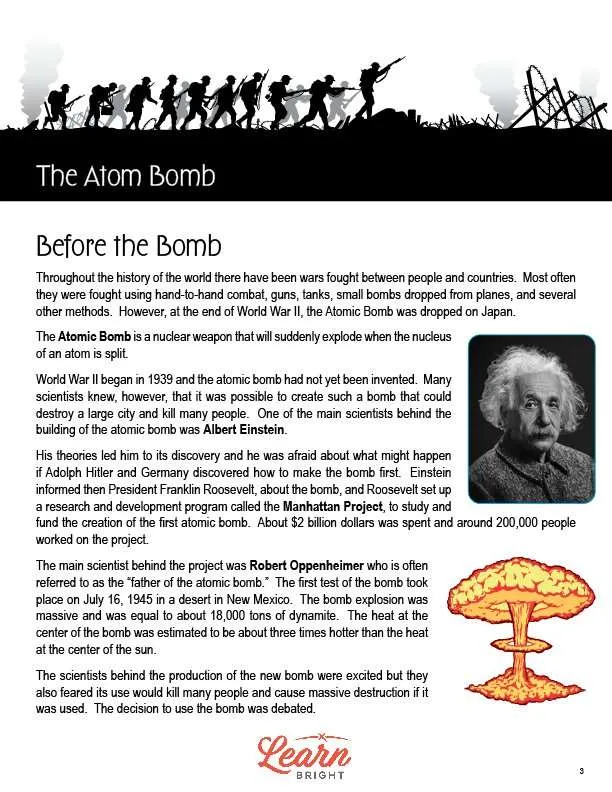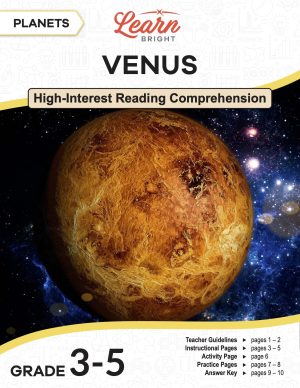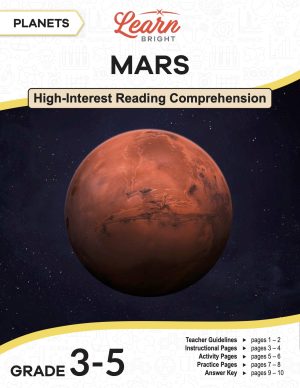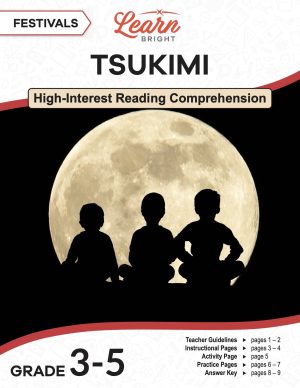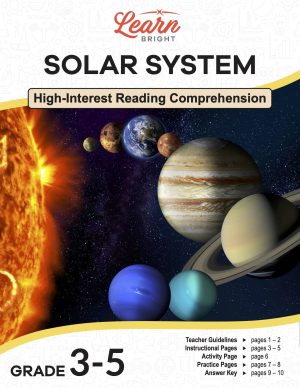Description
What our Atom Bomb lesson plan includes
Lesson Objectives and Overview: Atom Bomb explores the effects of an atomic bomb as a wartime strategy and introduces the history of the atomic bombs that the United States dropped on Japan during the end of WWII. At the end of the lesson, students will be able to define and identify the atomic bomb that was dropped on Japan during the end of WWII. This lesson is for students in 5th grade and 6th grade.
Classroom Procedure
Every lesson plan provides you with a classroom procedure page that outlines a step-by-step guide to follow. You do not have to follow the guide exactly. The guide helps you organize the lesson and details when to hand out worksheets. It also lists information in the orange box that you might find useful. You will find the lesson objectives, state standards, and number of class sessions the lesson should take to complete in this area. In addition, it describes the supplies you will need as well as what and how you need to prepare beforehand.
Options for Lesson
Included with this lesson is an “Options for Lesson” section that lists a number of suggestions for activities to add to the lesson or substitutions for the ones already in the lesson. For an additional lesson activity, you can split your students into two groups for a debate, with one group opposed to dropping the atomic bomb and the other in favor. You can also have your students do in-depth research into the atomic bomb and the Manhattan Project. You can use the practice page as a quiz or test instead of an in-class assignment. For an additional activity, you could invite someone who was alive in 1945 to speak to your class about their memories and experiences of that time. Finally, you can have students debate the positives and negatives of nuclear power.
Teacher Notes
The teacher notes page includes a paragraph with additional guidelines and things to think about as you begin to plan your lesson. This page also includes lines that you can use to add your own notes as you’re preparing for this lesson.
ATOM BOMB LESSON PLAN CONTENT PAGES
Before the Bomb
The Atom Bomb lesson plan includes three pages of content. People have fought wars throughout the history of the world. For a long time, people fought wars using hand-to-hand combat, guns, tanks, small bombs, and more. And then at the end of World War II, the United States dropped two atomic bombs on Japanese cities. The atomic bomb is a nuclear weapon that explodes by splitting the nucleus of an atom.
World War II started in 1939. At this time, we had not yet invented the atomic bomb. At this time, many scientists knew that it was possible to create a bomb that could destroy a whole city and kill many, many people. Albert Einstein was one of the main scientists who contributed to the building of the atomic bomb.
Einstein’s theories led to his discovery and he worried that Hitler and the Germans would figure out how to make the bomb first. He spoke to President Franklin Roosevelt about the bomb, and Roosevelt decided to set up a research and development project to study and fund the creation of the bomb called the Manhattan Project. They spent about $2 billion on the project, which around 200,000 people worked on.
Robert Oppenheimer was the main scientist in charge of this project. We often call him the “father of the atomic bomb.” On July 16, 1945, they completed the first test of the bomb in New Mexico. The explosion was huge, equalling 18,000 tons of dynamite. The center of the bomb was three times hotter than the center of the sun.
The scientists who worked on the project were excited but fearful of what would happen if they used the bomb. They debated whether anyone should use the bomb or not.
Using the Bomb
They started having a debate about whether to drop the bomb on Japan near the end of World War II. At this time, Germany had already surrendered and the war was essentially over. Japan, however, refused to surrender. The United States military thought about invading Japan but thought that thousands of soldiers would die if they did so. President Harry Truman finally decided to drop the atomic bomb on the Japan.
This was a controversial decision that scientists and politicians still debate today. The people who were against dropping the bomb had concerns about how many innocent civilians would die. They thought there were other ways to get Japan to surrender. Other people argued that dropping the bomb would be the only way to get Japan to surrender.
The United States dropped the first bomb, called Little Boy, on the city of Hiroshima, Japan on August 6, 1945. It destroyed the city and instantly killed tens of thousands of people. They dropped the bomb from a plane called the Enola Gay. It weighed about 10,000 pounds and was 10 feet long. They attached a parachute to the bomb to slow it down so their plane had time to escape the blast zone.
On August 9th, the U.S. dropped a second bomb, called Fat Man, on the city of Nagasaki, Japan, after Japan still refused to surrender. It killed many civilians. Both bombs killed between 130,000 and 250,000 either instantly or in later years from the radiation exposure.
After the Bomb
President Truman gave a public statement on why they used the bombs, which the lesson includes the text of. People will likely continue to debate the use of the bomb forever. Japan officially surrendered six days after the U.S. dropped the second bomb on Nagasaki. Hirohito, the Emperor of Japan at this time, surrendered to U.S. forces.
The majority of the damage from the bombs was from the initial blast. It causes a huge shock wave which produces changes in air pressure. It crushes objects, the high wind knocks structures over, and it creates a large crater on the surface of the earth. Debris becomes radioactive and “black rain” falls.
The people in the area receive two doses of intense radiation. The first is from the explosion and the second is from the fallout. People as far as five miles away get skin burns from the heart. People burn to death. Radiation exposure can cause immediate death or can lead to health problems for the rest of their lives.
After the bombs, the United States gained a lot of political power. This event also caused a nuclear arms race with other countries, who started producing nuclear bombs themselves. Many countries have nuclear weapons, and some people believe that the number of these weapons existing actually prevents wars from starting between different countries.
Key Terms
Here is a list of the vocabulary words students will learn in this lesson plan:
- Albert Einstein: One of the main scientists behind the building of the bomb
- Manhattan Project: Program set up to study and fund the creation of the bomb
- Robert Oppenheimer: Scientist often referred to as the “Father of the Atomic Bomb”
- Harry Truman: Person who made the final decision to drop the A-Bomb
- Hiroshima: The Japanese city the first A-Bomb was dropped
- Enola Gay: Name of the plane carrying the first atomic bomb
- Nagasaki: The Japanese city the second A-Bomb was dropped
- Hirohito: Emperor of Japan when the atomic bombs were dropped
ATOM BOMB LESSON PLAN WORKSHEETS
The Atom Bomb lesson plan includes three worksheets: an activity worksheet, a practice worksheet, and a homework assignment. You can refer to the guide on the classroom procedure page to determine when to hand out each worksheet.
DISCUSSION ACTIVITY WORKSHEET
Students will work in groups to complete the lesson activity. Each group will discuss the provided set of questions. They will list both opposing opinions and opinions the group agrees with. They will use their notes for a full-class discussion.
Students can also work in pairs or larger groups to complete this activity if you’d prefer.
MATCHING PRACTICE WORKSHEET
For the practice worksheet, students will first match people, places, and things to their descriptions. They will then match dates and numbers the correct description.
ATOM BOMB HOMEWORK ASSIGNMENT
The homework assignment asks students to use the internet and other sources to define each term and answer the additional questions about each term or event.
Worksheet Answer Keys
This lesson plan includes answer keys for the practice worksheet and the homework assignment. If you choose to administer the lesson pages to your students via PDF, you will need to save a new file that omits these pages. Otherwise, you can simply print out the applicable pages and keep these as reference for yourself when grading assignments.



